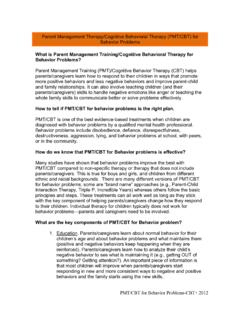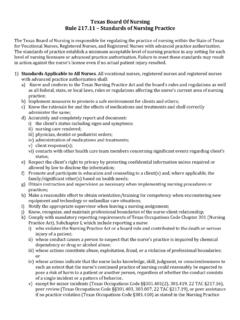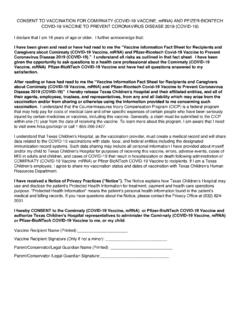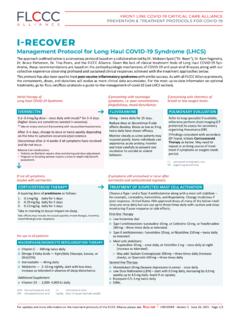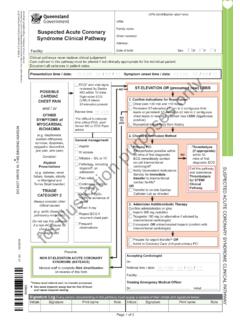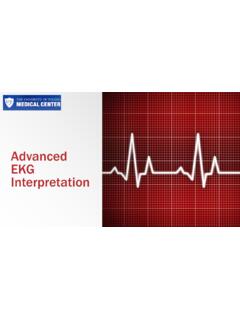Transcription of 4. Nursing Care for the Infant with Neonatal Abstinence ...
1 Nursing CARE FOR THE Infant WITH Neonatal Abstinence SYNDROMEL earning Objectives Discuss the increased incidences of maternal opioid use Learner will describe the mechanism and clinical presentation of NAS Learner will describe scoring tools for NAS Learner will recognize recommended pharmacologic treatment for NAS Learner will describe Nursing interventions for patients with NAS Learner will describe teaching points for parentsMaternal Drug Use & NAS Growing Epidemic Over 238 million prescriptions were written for opioid analgesics in 2011. of pregnant women abused opioids with being opioid pain relievers and heroin. (Substance Abuse and Mental Health Services Administration, 2011) In a national study, maternal opioid use was shown to have increased: mothers per 1000 births in 2000 to mothers per 1000 births in 2009 Between 2014 2015 NAS exposed infants increased from to per 1000 births.
2 Total economic burden totaled over 1 billion nationally in 2015 Maternal Drug Use & NAS Growing Epidemic Increased incidence of NAS has been uniformly reported across community hospitals, teaching hospitals and children s hospitals. NAS affects all communities and ethnicities APP recommends: All nurseries caring for infants with NAS, develop guidelines for screening for maternal substance abuse Formulate standard plans of care to identify newborns at risk and manage their careWhat is Neonatal Abstinence syndrome (NAS) Generalized multi-system disorder that predominately involves the central and autonomic nervous system as well the gastrointestinal tract. Infants exposed to opioids/narcotics during gestation will begin experiencing withdrawal with the abrupt cessation of these substances after birth What makes them susceptible First case documented in 1875 Effects of NAS Economic Long-termDiagnosis Comprehensive prenatal medical and drug history, especially in respect to polydrugabuse R/O other conditions Laboratory data Serum glucose Serum calcium/magnesium Urine test for toxicology Meconium drug analysisDiagnosis cont d Observation for common signs/symptoms associated with NAS Presentation of symptoms.
3 Shortly after birth and up to 2 weeks of age Majority are exhibited with 36-72 hours Severity of symptoms depends on multiple factorsSigns & Symptoms of NASCOMMONSIGN & SYMPTOMS OF NASN eurologicExcitabilityGI DysfunctionAutonomic SignsTremorsIrritabilityIncreased wakefulnessHighpitched cryHyperactive tendon reflexesSeizuresFrequent yawning and sneezingPoor feedingUncoordinatedand constant suckingVomitingDiarrheaDehydrationPoor weight gainIncreased sweatingNasal stuffinessFeverMottlingTemperatureinstab ilityAbstinence Scoring Tools Observer reported questionnaires used for assessing severity of withdrawal, determining need and duration and titration of pharmacologic therapy. Finnegan Neonatal Abstinence Scoring Tool (FNAST) Eat, Sleep, ConsoleFinnegan Neonatal Abstinence Scoring Tool (FNAST) Most widely used and accepted tool Recommended by APPF innegan Neonatal Abstinence Scoring Tool (FNAST) Limitations of the tool Reliability & Validity ComplexityEat, Sleep, Console (ESC) Developed in 2017, program to manage NAS based upon the neonate s ability to function Less complex Evaluates 3 criteria: Empowers parents Administration of MorphineEat, Sleep, Console (ESC) Average length of stay from to d Pharmacologic treatment with Morphine from 98% to 14% Costs from $44,824 to $10,289 per patient Research on ESC has shown.
4 Pharmacologic Management Oral Morphine First line choice in majority of NICUs Short half-life administered Q 3-4 hours Improves feeding, eliminates diarrhea, agitation Prolongs hospital stay Oral Methadone 15% of NICUs use as first line Alternative to Morphine Long half life can only be administered twice per day Phenobarbital Drug of choice for non-opiate NAS/polydruguse Often used as adjunct to Morphine or Methadone Effective in controlling irritability and insomnia Oral Clonadine Decreases symptoms such as tachycardia , hypertension, diaphoresis, restlessness and diarrhea Cessation of treatment can result in a rebound of these and NAS Infants with Methadone- or Buprenorphine- dependent mothers has been identified as safe and beneficial regardless of dose Lactation Support ContraindicationParental Presence The goals of care should be patient- and family-centered.
5 It is the patient we treat, but it is the family of whatever construct, with whom the baby will go home. Indeed, it is the family who must live with the long-term consequences of our daily decisions in caring for their baby. (Brian Carter Merenstein& Gardner s Handbook of Neonatal Intensive Care) Positive impact Importance of positive nurse-parent relationshipNon -Pharmacologic Interventions Rooming-In Stimulation Safe swaddling Developmental Positioning Vertical rockers Music, massage and aromatherapyParent Teaching Symptoms may persist for 2-6 months Importance of second caregiver Safe Sleep education Importance of follow-up with primary physician Provide information on community based support systemsQUESTIONS?
6 ReferencesKumar, R., & Garg, S. (2019). Neonatal Abstinence syndrome : a current ,15(4), 132 , L. M., Stephen, M. M., Coykendall, M. R., Kane, M. F., Maurer, J. A., & Bader, M. Y. (2019). Eat, Sleep, Console Approach: A Family-Centered Model for the Treatment of Neonatal Abstinence in Neonatal Care,19(2), 138 144. doi: , D. B., Peat, J. R., O'Donnell, S., Graham, E., & Malcolm, W. F. (2019). "Choose Physical Therapy" for Neonatal Abstinence syndrome : Clinical Management for Infants Affected by the Opioid Therapy,99(6), 771 785. doi: /pzz039 Oji -Mmuo, C. N., Schaefer, E. W., Liao, L., Kaiser, J. R., & Sekhar, D. L. (2019). The Possibility of Early Discharge for Newborns Being Monitored for Neonatal Abstinence syndrome Based on Modified Finnegan Score Pediatrics,58(6), 641 646.
7 Doi: , B. L., Holmes, A. V., & Blythe, S. (2019). Models of care for Neonatal Abstinence syndrome : What works?Seminars in Fetal and Neonatal Medicine,24, 121 132. Retrieved from , E., & Duryea, D. G. (2019). The role of mother- Infant bond in Neonatal Abstinence syndrome (NAS) of Psychiatric Nursing ,33, 267 274. Retrieved from , M. T. (2019). Time for the Finnegan Neonatal Abstinence syndrome Scoring Tool to Be Retired?The Journal of Perinatal & Neonatal Nursing , 276 277. doi : , L., & Finnegan, L. P. (2017). Neonatal Abstinence syndrome : where are we, and where do we go from here?Current Opinion-Psychiatry,30, 268 274. doi : continuedClark, L., & Rohan, A. (2015). Identifying and Assessing the Substance-Exposed , The American Journal of Maternal /Child Nursing ,40(2), 87 95.
8 Doi : , V. (2014). Management of Neonatal Abstinence syndrome in the Newborn for Women's Health,18(6), 509 514. doi: , P. (2014). Neonatal Abstinence ,134(2), e547 e561. doi : , L. M., Velez, M., & Harrow, C. (2009).The Opioid Exposed Newborn: Assessment and Pharmacologic Management. Baltimore. Retrieved from , M., Owens, L., & Placencia, J. (2017). Neurology. Guidelines for Acute Care of the Neonate (25th ed., pp. 129 132). Houston, TX: Section of Neonatology, Department of Pediatrics Baylor College of , S. M., & Finnegan, L. P. (2016). Drug Withdrawal in the Neonate. InMerenstein& Gardner's Handbook of Neonatal Intensive Care (8th ed., pp. 199 217). St. Louis, MO: , T., Ashley, T.
9 , & PravikoffD. (2018). Neonatal Abstinence syndrome : an Overview CINAHL Nursing Guide, EBSCO Publishing (Quick Lesson CEU)




